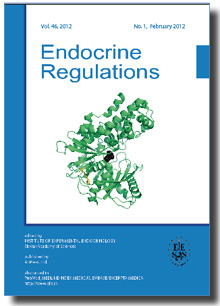Journal info
|
||
Select Journal
Journals
Bratislava Medical Journal Ekologia - Ecology Endocrine Regulations 2015 2014 2013 2012 2011 2010 2009 2008 2007 2006 2005 2004 2003 General Physiology and Biophysics Neoplasma Acta Virologica Studia Psychologica Cardiology Letters Psychológia a patopsych. dieťaťa Kovove Materialy-Metallic Materials Slovenská hudba 2025Webshop Cart
Your Cart is currently empty.
Info: Your browser does not accept cookies. To put products into your cart and purchase them you need to enable cookies.
Endocrine Regulations Vol.38, p.167-171, 2004 |
||
| Title: COMPARISON OF INSULIN SENSITIVITY INDICES CALCULATED FROM STANDARD 3-SAMPLED AND FREQUENTLY SAMPLED ORAL GLUCOSE TOLERANCE TEST | ||
| Author: Adela Penesova, Zofia Radikova | ||
| Abstract: Objective. Three-sampled oral glucose tolerance test is the most frequently used method for evaluation of impairment of glucose homeostasis in daily clinical practice. The aim of this study was to answer the question if insulin sensitivity indices (ISI) calculated from standard 3-sampled oral glucose tolerance test (3SoGTT) provide adequate information compared to the outcome when calculated from frequently sampled oral glucose tolerance test (FSoGTT).
Methods. A total of 73 subjects (aged 17-59 years, BMI 17.9- 41.8 kg/m2) underwent a standard frequently sampled oral glucose tolerance test (FSoGTT). Selected indices of insulin sensitivity were calculated using plasma glucose and insulin concentrations from FSoGTT and from samples obtained in 0, 60 and 120 min of the oGTT (3SoGTT). Areas under the peripheral concentration curves of insulin and glucose (AUCi, AUCg) from both approaches were compared.
Results. Insulin sensitivity calculated from 3SoGTT was significantly higher compared to the sensitivity calculated from FSoGTT expressed as insulin sensitivity indices ISI Cederholm (ISI(Ced)) and ISI Matsuda (ISI(Mat)), p<0.001 and p<0.05, respectively. There was a difference in AUCg between values estimated from 3SoGTT and FSoGTT (p<0.05). These differences nearly disappeared when the BMI groups (normal weight and overweight/obese) were evaluated separately. No differences were found in AUCi and the AUCg : AUCi ratio between two approaches.
Conclusions. It might be supposed that on using 3SoGTT the ISI(Mat) provides greater objectivity in assessing insulin sensitivity than ISI(Ced). Although insulin sensitivity is overestimated when calculated from 3SoGTT, the approach is still valuable for identifying subjects with insulin resistance. |
||
| Keywords: Glucose – Insulin – Insulin sensitivity indices – Glucose tolerance | ||
| Year: 2004, Volume: 38, Issue: | Page From: 167, Page To: 171 | |
|
|
 download file download file |
|

